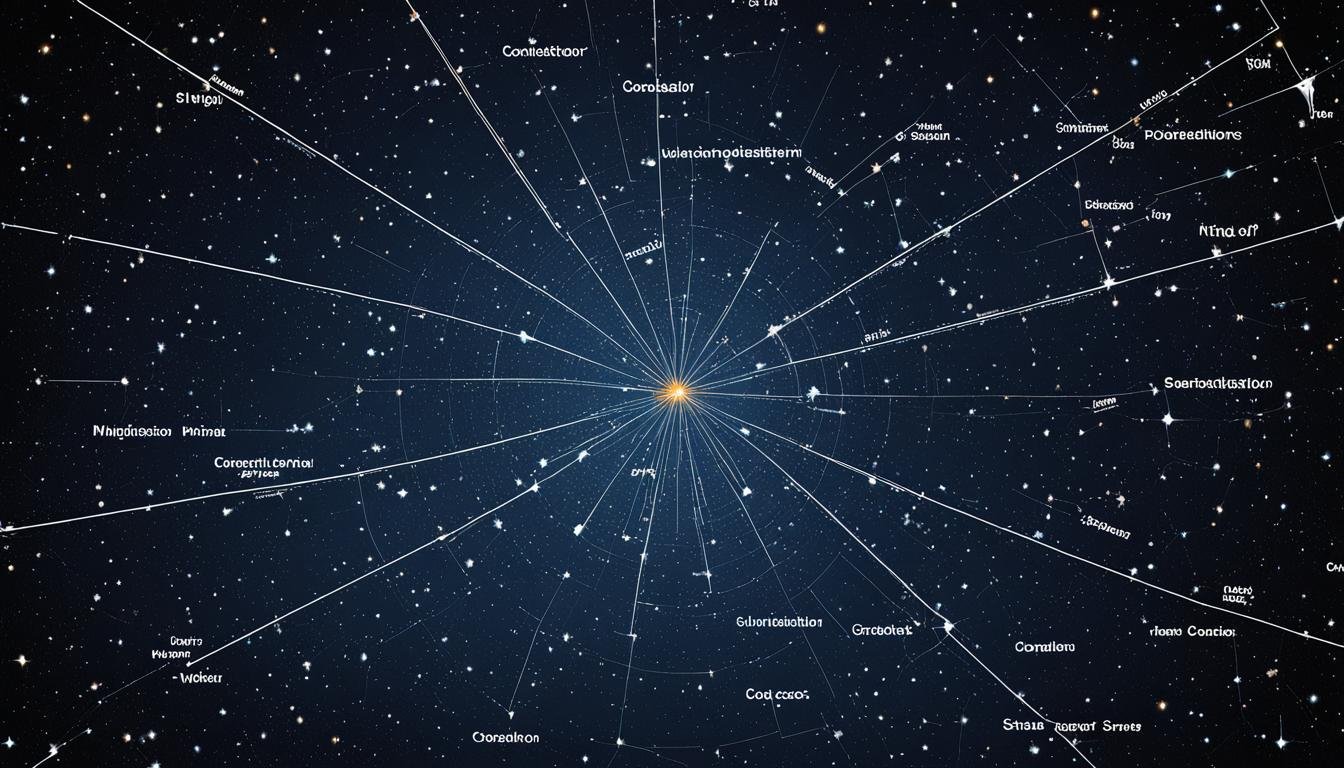| Genitive | Andromedae |
| Abbreviation | And |
| Pronunciation | (an-DROM-ih-duh) |
| Main Stars | 16 |
| Brightest Star | Alpheratz (α And) (2.07m) |
| Right Ascension | 1 hour |
| Declination | 40 deg |
| Sq. Deg. Area | 722 |
| Crosses Meridian | 9 PM, Nov 10 |
| Visible Lat. Range | 90, -40 deg |
As you embark on a celestial journey through the stars, the Telescopium constellation beckons as an astronomical monument to human ingenuity. Nestled in the southern night sky, this lesser-known tapestry of stars may not dominate the headlines like its more famous counterparts, but its subtle glow harbors a rich tapestry of cosmic wonders. With its history rooted in the 18th-century vision of Nicolas Louis de Lacaille, the Telescopium astronomical object stands as a tribute to the telescope, a tool that revolutionized our gaze into the vastness of space.
Dive into the heart of the constellation Telescopium, facts about its brightest stars and deep sky treasures await your discovery. While devoid of ancient mythological tales, its story is etched in the annals of scientific progress, offering a unique narrative in the constellation canon. Whether you’re a seasoned astronomer or a curious stargazer, Constellation Telescopium’s history boasts a narrative punctuated by the unyielding human quest to fathom the heavens.
Designed to captivate your imagination and fuel your astronomical aspirations, this guide is your companion through the expanses of Telescopium. Together, we’ll unearth the secrets held within its stellar confines—from the blazing path of Alpha Telescopii to the faint, distant galaxies that call this segment of sky their home.
Key Takeaways
- Telescopium constellation, known as ‘The Telescope’, is an homage to one of astronomy’s most significant inventions.
- Located south of celebrated constellations, Telescopium offers a tranquil observation field for stargazers.
- Alpha Telescopii, the constellation’s brightest star, is a beacon amidst the fainter celestial bodies.
- The history of Telescopium is marked by scientific ingenuity rather than mythological lore.
- Optimal visibility of this constellation occurs during August in the Southern Hemisphere.
- Telescopium is part of the Lacaille family, honoring the celebrated astronomer’s work.
Unveiling Constellation Telescopium: A Stargazer’s Primer
Embark on a celestial journey into the southern skies, where the Telescopium constellation awaits stargazers with its rich astronomical tapestry. With no ties to Constellation Telescopium mythology, this stellar mosaic is steeped in the annals of scientific progress, offering a unique narrative that blends the past with present cosmic exploration.
The Origin and History of Constellation Telescopium
In the 18th century, the adept astronomer Nicolas Louis de Lacaille commemorated the advancements of his era by naming the constellation after an aerial refractor telescope used by J.D. Cassini. Although it was once called Tubus Astronomicus, the name Telescopium triumphed, celebrating a pivotal period in human innovation. Telescopium, despite its relative obscurity, has a profound Telescopium constellation history, marked by a reduction in its size over time due to the reassignment of stars, while still claiming its rightful place among celestial formations.
Where to Spot the Telescope in the Night Sky
Idyllic for those nestled in the southern hemisphere, particularly within the fourth quadrant (SQ4), the Telescopium constellation can be identified using a Telescopium constellation map. To capture views of this understated beauty, look towards its neighbors — Ara and Sagittarius —, and partake in the storied tradition of skywatching that continues to enchant humanity.
Key Characteristics and Features of Constellation Telescopium
Devoid of dazzling stars, Telescopium is noted for its absence of stellar luminaries. Yet, within this celestial sprawl lie subtle wonders. The key feature is the notable Telescopium star cluster, a galactic gathering that hints at the secrets held deep within the cosmos. This modest selection of deep-sky objects reminds us that even in areas less traveled by the gaze of amateur astronomers, the universe still offers an array of fascinating phenomena.
In summary, the Telescopium constellation may not dominate night sky narratives with bright stars or mythical tales, but it’s a treasure trove for those intrigued by the quieter corners of our galaxy. Prepare to embrace the allure of this southern jewel, and in doing so, foster a deeper connection with the history and mystery of the cosmic expanse.
Stellar Showcase: Notable Stars in the Telescopium Constellation
As you embark on a celestial journey through the cosmos, the Telescopium constellation emerges as a scenic star-studded vista. This southern sky attraction hosts a variety of stellar entities, each with their own story and charm. As we delve deeper into this astronomical wonder, we showcase some of the most prominent stars that make up the fabric of the Telescopium constellation.
Alpha Telescopii: The Constellation’s Brightest Luminary
Undoubtedly, the star Alpha Telescopii dazzles as the brightest beacon within the bounds of Telescopium. This shimmering blue-white subgiant is 278 light years from our planet and boasts an apparent magnitude of 3.51. Known to astronomers as a slowly pulsating B star, Alpha Telescopii’s radiance is undiminished, making it an anchor point for observers and enthusiasts alike.
Examining the Subgiant and Giants: Zeta, Epsilon, and Lambda Telescopii
Following the luminary trail, Zeta Telescopii, a restful yellow giant radiating from 127 light years away, and Epsilon Telescopii, a binary system with a vivid orange giant at its heart, situated 420 light years distant, offer contrasting glimmers in the Telescopium tapestry. The constellation also boasts Lambda Telescopii, a white main-sequence star gleaming from 531 light years away, adding another layer to this starry mosaic.
Delta Telescopii and Its Stellar Companions
Navigating through the celestial depths, your gaze may set upon Delta Telescopii. This system is particularly enriched by twin stars: the blue-white subgiant Delta-1 and the grandiose giant Delta-2 Telescopii. Their proximal placement in the heavens offers a fascinating study in stellar companionship and harmony.
Whether you are an astrophotographer hunting down distant suns or a stargazer simply admiring the sky’s majesty, these standout stars make the Telescopium constellation stars a celestial exhibit worth exploring.
Astronomical Marvels: Exploring Telescopium’s Deep Sky Treasures
As you cast your gaze toward the southern sky, be prepared to unveil the hidden gems of the Telescopium constellation. Though not as renowned as other night sky spectacles, its Telescopium deep sky objects offer a rich tapestry of cosmic wonders waiting to be discovered. Among these are galaxies and clusters that astonish with their complexity and beauty.
The Telescopium Group, a cosmic gathering of galaxies, is a highlight for stargazers. This cluster introduces us to such majestic entities as NGC 6868 and NGC 6861. Each galaxy spins its own tale of size, shape, and stellar composition, collectively presenting a microcosm of the universe’s grandeur. On clear nights, these distant galaxies remind us of the vastness of space that cradles our existence.
A spiral galaxy named NGC 6850 beckons with its swirling arms, a hallmark of galactic formation. In contrast, the tightly bound stars of the NGC 6584 globular cluster provide a different spectacle, one that speaks of early galactic building blocks. For those with a penchant for celestial phantasmagoria, the planetary nebula IC 4699 delivers an ethereal viewing experience near the constellation’s more exuberant star, Alpha Telescopii.

| Object Name | Object Type | Noteworthy Features |
|---|---|---|
| Telescopium Group | Galaxy Cluster | Consortium of a dozen galaxies including NGC 6868 and NGC 6861 |
| NGC 6868 | Elliptical Galaxy | Schechter luminosity function exemplar within the group |
| NGC 6861 | Lenticular Galaxy | Known for its high surface brightness and central concentration |
| NGC 6850 | Spiral Galaxy | Displays well-defined spiral arms and active star formation regions |
| NGC 6584 | Globular Cluster | Rich with evolved stars and deep central concentration |
| IC 4699 | Planetary Nebula | Offers vivid views of gas expulsion from a dying star |
Identifying these Telescopium deep sky objects is a delightful endeavor for astronomy aficionados. The journey across the Telescopium constellation is a testament to the exploratory spirit that defines our quest to understand the universe. With each star’s twinkle and every galaxy’s glow, your night sky exploration is sure to be enriched by Telescopium’s deep sky treasures.
A Guide to Observing the Constellation Telescopium
As an avid stargazer, you may find yourself drawn to the lesser-known beauties of the night sky. Among these celestial wonders is the constellation Telescopium. Encased below the more prominent southern constellations, its subdued glimmer beckons the truly curious. Let’s embark on a journey to witness Telescopium at its finest.
Best Time and Locations for Viewing Telescopium
Identifying the Telescopium best viewing times is crucial for any successful stargazing expedition. Your optimal window to observe the constellation is during the tranquil August evenings, precisely at 9 p.m. This is when Telescopium ascends splendidly into the southern celestial theater. For those positioned between latitudes +40° and -90°, the view becomes increasingly spectacular, offering a backdrop that endears astronomers and enthusiasts alike.
Telescopic Wonders: Enhancing Your Telescopium Experience
While you can certainly appreciate Telescopium’s allure with the naked eye, Telescopium telescopic views open up a universe of profound wonders. Deploying a telescope enables you to delve deeper into the constellation’s elusive charm, unveiling faint stars and mesmeric deep sky objects that would otherwise remain unseen. Beholding these celestial objects through the lens is akin to discovering hidden treasures of the cosmos.
Navigating Telescopium’s Expanse with Constellation Maps
For astronomy enthusiasts, employing Telescopium star maps is an indispensable strategy. These guides serve as your celestial compass, empowering you to sail across the constellation’s vast expanse with confidence. A detailed map not only facilitates the identification of Telescopium’s stars but also enhances your understanding of its place amongst the heavenly tapestry.

| Telescope Feature | Benefit for Observing Telescopium |
|---|---|
| High Magnification | Reveals fainter stars within the constellation |
| Wide Field of View | Captures extensive regions, showcasing the constellation’s true breadth |
| Computerized Go-To Mount | Locates specific stars and deep sky objects with precision |
| High-Quality Optics | Ensures crisp, clear views of celestial phenomena |
Constellation Telescopium: Merging Science and Mythology
As your gaze lifts to the heavens, you behold the subtle majesty of the Telescopium constellation—a celestial tapestry devoid of mythology yet rich with the narrative of scientific triumphs. Unlike its more storied kin, Telescopium forgoes ancient tales to embody the relentless human spirit seeking cosmic truths. With each star within its domain, you witness the unfolding story of scientific discoveries in Telescopium, a humble reminder of our place in this vast universe.
The journey through Telescopium is not just of interstellar observation but an ode to innovation, as symbolized by its very namesake, the telescope. This instrument has been pivotal in broadening human perspective, transforming specks of light into worlds of potential and scientific revelation. Your exploration of its stars, from the notable Alpha Telescopii to the less luminous but equally significant members, contributes to understanding the Telescopium astronomical significance. Each celestial body stands as proof of the ongoing dialogue between the cosmos and the curious minds striving to decode it.
Indeed, within the boundaries of this constellation lies the Telescopium Galaxy Group, a galactic community that beckons astronomers and astrophotographers alike. These galaxies, distant and majestic, serve as cosmic laboratories where hypotheses are tested, and the fabric of space divulges its secrets. As you connect with the essence of Telescopium, remember that each observation, each gaze skywards, enriches your grasp of the universe—a practice once rooted in myth now grounded in the observable, tangible reality that is astronomy.
FAQ
What is the Telescopium constellation and where is it located?
The Telescopium constellation, also known simply as “The Telescope,” is a constellation situated in the southern sky. It’s bordered by the constellations of Sagittarius and Corona Australis. Telescopium is recognized for representing the telescope, a crucial tool for astronomical observations.
Who named the Telescopium constellation and why?
Nicolas Louis de Lacaille, an 18th-century French astronomer, named the constellation Telescopium to honor the invention of the telescope and the significant advancements it brought to the field of astronomy.
Does the Telescopium constellation hold any significance in mythology?
Unlike many other constellations, Telescopium doesn’t have any associated myths. Its name is a tribute to scientific innovation rather than to mythological tales.
What are the key features of the Telescopium constellation?
Telescopium is notable for its faint stars and lacks Messier objects or confirmed exoplanets. The constellation’s most prominent features include its brightest star, Alpha Telescopii, and a selection of deep sky objects like the Telescopium Group of galaxies.
Can you see the Telescopium constellation with a naked eye, or do you need a telescope?
While Telescopium’s stars are relatively faint, its brightest star, Alpha Telescopii, can be seen with the naked eye under good viewing conditions. However, to truly appreciate the deep sky objects within Telescopium, a telescope would be beneficial.
When is the best time to observe the Telescopium constellation?
The most opportune time to view the Telescopium constellation is in August, at around 9pm. This is when it is most prominent in the sky, especially from locations in the Southern Hemisphere.
How do you find the Telescopium constellation in the night sky?
To locate the Telescopium constellation, you can use constellation maps, which will help you identify its position in the southern sky’s fourth quadrant (SQ4). It’s best to look for it between the latitudes of +40° and -90°, neighboring constellations like Ara and Sagittarius can serve as reference points.
What are some notable stars and deep sky objects in Telescopium?
Alpha Telescopii is the brightest star in the constellation. Deep sky objects of interest include the Telescopium Group with galaxies like NGC 6868 and NGC 6861, the spiral galaxy NGC 6850, the globular cluster NGC 6584, and the planetary nebula IC 4699.
What can one learn from observing the Telescopium constellation?
Observing the Telescopium constellation can provide insights into a part of the night sky rich with galaxies and stellar formations. It’s an opportunity to connect with the history of astronomical observation and appreciate the technological advancements embodied by its namesake, the telescope.






